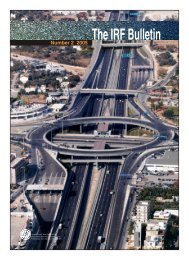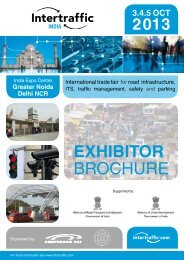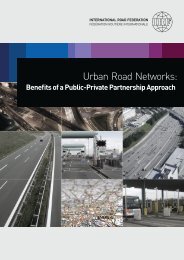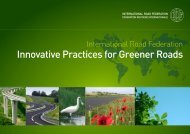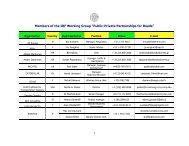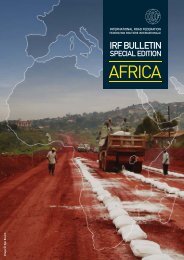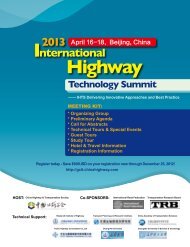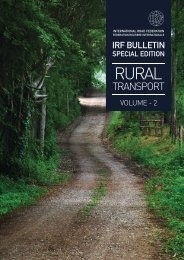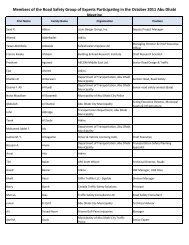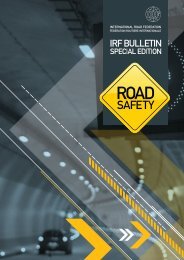Download - IRF | International Road Federation
Download - IRF | International Road Federation
Download - IRF | International Road Federation
Create successful ePaper yourself
Turn your PDF publications into a flip-book with our unique Google optimized e-Paper software.
SUSTAINABLE ROADS<br />
with conventional paving grade bitumen is sometimes not<br />
feasible or even not desirable in high rainfall areas due to<br />
intermittent rains throughout the year which affect the<br />
production and laying of hot mixes. At high altitude or in<br />
snow-bound areas, hot bitumen gets solidified quickly<br />
and looses its binding property, when it comes in contact<br />
with existing pavement surface. Cutback bitumen is,<br />
therefore, specified to overcome such problems in these<br />
environments which requires little heating but is<br />
accompanied by emission of solvents used as cutter<br />
stock, which create environmental problems.<br />
The use of bitumen emulsion eliminates the heating of<br />
the binder and aggregate and thus prevents degradation<br />
of the environment and conserves energy. Despite being<br />
a versatile material with several advantages, use of<br />
bitumen emulsion in India is only about 2.7% of<br />
total consumption as compared to 43% in<br />
Switzerland, France and other European countries.<br />
This is probably due to inexperience in use of this<br />
technology, non-availability of proper plants and<br />
machinery and inadequate quality of bitumen emulsions.<br />
Central <strong>Road</strong> Research Institute, R & D Centre of Indian<br />
Oil Corporation Ltd. and Border <strong>Road</strong>s jointly undertook<br />
field trials for the first time in India to study the technoeconomic<br />
viability/feasibility of use of cold mix technology<br />
using bitumen emulsion with an objective of promoting<br />
the technology in the country through the development<br />
of guidelines and specifications. In this paper the design<br />
and construction, problems faced and experience gained<br />
during preparation and laying of cold mixes, and<br />
performance of test sections with bitumen emulsion<br />
under different climatic conditions are described. The<br />
conclusions are drawn from the study.<br />
Extract from results: The performance of PMC with<br />
emulsion and PMC with bitumen is plotted against the<br />
pavement's service life ( see figure below). As can be<br />
seen, the performance of PMC with emulsion is better in<br />
comparison to PMC with bitumen. The performance<br />
evaluation shows that the service life of PMC with<br />
emulsion is about 6 years while it is about 4 years for<br />
PMC with bitumen at the limiting value of 50 percent<br />
marks.<br />
The performance of SDBC with emulsion and SDBC with<br />
bitumen was almost similar and comparable after 3 years<br />
of service, since the marks obtained were 75% and 76%<br />
respectively. The performance of the test section and<br />
control sections after 5 years of service was also found to<br />
Performance, %<br />
Fig-1: Performance of PMC on NH-1A<br />
Emulsion Bitumen<br />
100<br />
90<br />
80<br />
70<br />
60<br />
50<br />
40<br />
30<br />
20<br />
10<br />
0<br />
0 1 2 3 4 5 6 7<br />
Service Life, Years<br />
be not much different since the marks obtained were<br />
55% and 65% respectively. A graph between the<br />
performance v/s pavements service life over a period of<br />
time is give in the figure below which shows comparable<br />
performance/ life of test section and control section.<br />
Extract of conclusions: a premix carpet (PMC) with<br />
bitumen emulsion provides better performance than<br />
with neat bitumen. This result applies across climatic<br />
areas. The service life of PMC with emulsion was 6 years<br />
while PMC with bitumen was 4 years in a snow bound<br />
area. The service life of PMC with emulsion was 5 years<br />
while PMC with bitumen was 4 years in a high rainfall<br />
area. The service life of PMC with emulsion was 4 years<br />
while PMC with bitumen was 5 years in a desert climate.<br />
Performance, %<br />
Fig-1: Performance of SDBC on NH-1A<br />
100<br />
Emulsion Bitumen<br />
90<br />
80<br />
70<br />
60<br />
50<br />
40<br />
30<br />
20<br />
10<br />
0<br />
0 1 2 3 4 5 6 7<br />
Service Life, Years<br />
A liquid seal coat on premix carpet with bitumen<br />
emulsion provides better performance. Sand seal coat is<br />
problematic as mixing emulsion with sand leads to ball<br />
formation. The quantity of bitumen emulsion provided for<br />
PMC in the tentative specification IRC: 97-1987 was<br />
observed towards the higher side. The code of PMC with<br />
emulsion has been revised, with recommendation of a<br />
lower quantity of bitumen emulsion than specified in the<br />
tentative specification.<br />
<strong>IRF</strong> BULLETIN SPECIAL EDITION : ASIA & OCEANIA<br />
28



